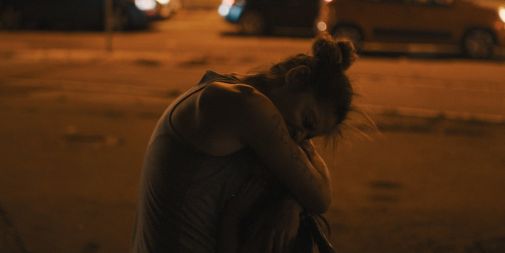Doc Corner: 'Museum of the Revolution'
 Sunday, May 21, 2023 at 10:00AM
Sunday, May 21, 2023 at 10:00AM 
In director Srđan Keča’s Museum of the Revolution (Muzej revolucije), the titular building is never seen as it was once envisioned. A tribute to communism in an area now recognised as Serbia, plans were abandoned following the breakup of Yugoslavia. The opening frames of this sobering documentary feature silent, sepia-toned (to the point of orange) archival footage of what appear to be a groundbreaking ceremony for the renovation of Belgrade after the war full of hope and promise (however politically misguided). The museum was never completed.
We quickly learn that the remnants of it sit abandoned and derelict, a shelter from the elements for homeless peoples. Among them is Mara and her daughter, Milica, as well as an elderly woman named Vera who acts sometimes as babysitter, attempting to empart any bit of wisdom onto the girl. In what was meant to be a monument to revolution, now sits as a stark reminder of what society does with the remains of progress.
Museum of the Revolution is a bleak film. As such it can be hard to engage with beyond its affecting central story. Mara works washing windscreens for meagre money, most of which is spent on sending packages to her imprisoned husband. Mother and daughter walk the street to their favourite spots, oftentimes past school playground where children much like Milica scream and shout with abandon. Around then, the city expands and grows with new apartment buildings and cosmopolitan infrastructure. At one such opening, an announcer says that particular performance space will be “a place for all of you”. Which is, of course, a bit rich considering it is only the wealthy of Serbia’s society who would likely ever be able to do so. The only thing that is maybe different about this and the unfinished museum at this doc’s core is that this new performance area offers the west a more progressive view of the country no matter what it represents to its citizens who are going hungry and uneducated.

But that’s how these things go, isn’t it? Time, money and resources are put into wonderful even well-meaning infrastructure initiatives that pave over the lives of the homeless and less fortunate. All while those very people who have no hope of ever being able to make use of it are displaced yet again with nowhere to go.
Keča, born in the former Yugoslavia but a resident of the United States, is able to capture this with potent humanist skill. His own cinematography is even able to capture some beautiful, interesting compositions among its sea of grey. The ripple of a dripping pond refracting in the light on the museum’s ceiling. Or the fluorescent lights that illuminate a bridge as the camera swoops underneath, like the cinema verité opposite of a near identical shot in Michael Mann’s Miami Vice film of 2006.
In many ways, Museum of the Revolution reminded me of another film: Radu Ciorniciuc’s Acasă, My Home. Like that film, which was set in Romania, Keča is able to capture a city in transition from the perspective of those on its fringes—people already pushed aside and only being pushed further away from the promise of a new future being proposed by those in power by every new building and every new government initiative.
Unlike that film, however; Museum of the Revolution is a bit harder to take in. Even at just 90 minutes, even the most committed of devotees to this sort of documentary work may find its dispatch from the streets a bit too much like hard work. Maybe that's just me having seen quite a few fils like that that show, quite rightly, the bleak and sad world around us. Watching this mother and daughter as they exist, both clearly affected by the hustle of merely staying alive but not entirely beaten by it, is a struggle. While there are minor moments of light that come from the young Milica particularly as she interacts with the elderly Vera, they are rare and really only seek to highlight the sadness of this life they find themselves in.
Maybe I am just a bit basic, but I think it would have been wise to have continued throughout what it was able to do in its brief opening montage of the reconstruction of Belgrade. The movie closes out once again with juxtaposed images of the shiny and new with the empty and dilapidated. Srđan Keča may not have wanted to underline the ideas and themes of his film quite so much, which I understand, but the additional context could have only helped to emphasise both how much and how little has changed for people like Mara, Milica and Vera in a city and a world that is eager to move as rapidly as it possibly can.
Release: Currently screening at the Firehouse in NYC with presumably a few more places to follow before VOD.
Award chances: I would say not likely, as it's a bit small and unlike A House Made of Splinters, which had a similar vibe and landed an Oscar nomination, doesn't have the profile.
 Doc Corner,
Doc Corner,  Review,
Review,  documentaries
documentaries 


Reader Comments (1)
Thank you for sharing the article. I am very interested in the information you have shared
eggy car